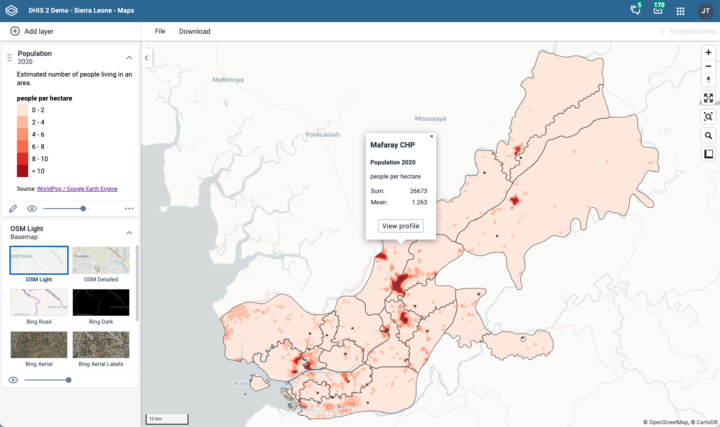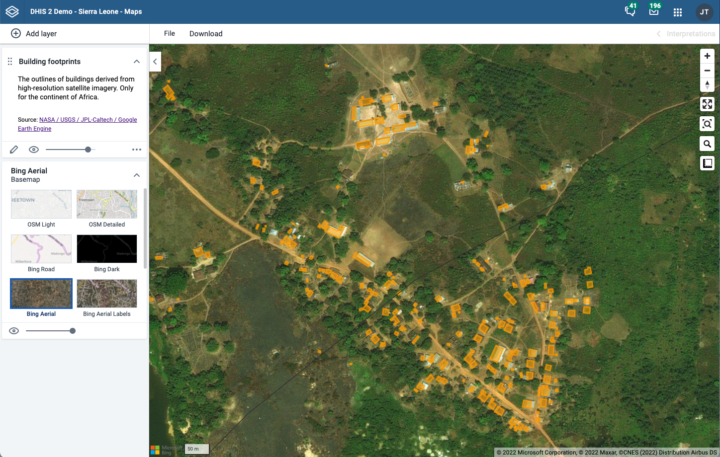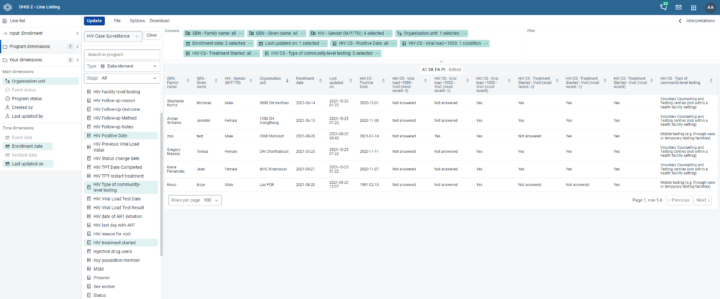Esta página ha sido traducida de manera automática y puede contener errores
Visión general de DHIS 2.38
Ya está disponible la versión 2.38 de DHIS2, con muchas funciones nuevas, mejoras y correcciones de errores.
En esta página puedes encontrar información sobre esta versión del software, incluidas descripciones de funciones, enlaces a documentación técnica y mucho más
Enlaces directos al contenido de la página
Vídeos de demostración de funciones
Descubre algunos aspectos destacados de las nuevas funciones de esta versión de DHIS2 con demostraciones de funciones realizadas por expertos en DHIS2.
Disponible mediante Entrega Continua
A continuación se indican las actualizaciones de las aplicaciones más destacadas que se han desarrollado durante el ciclo de lanzamiento de la v2.38, pero que no se incluyen en el paquete de la versión v2.38.0.
Podrás instalar estas aplicaciones principales directamente desde el App Hub, y hacer que la nueva versión sustituya a la versión incluida en DHIS2 mediante la aplicación App Management.
- App Lista de Líneas
- App Captura – Funcionalidad Rastreador
En los apartados correspondientes se incluye una visión general de las principales características de estas aplicaciones.
Funciones analíticas

Zonas de captación de unidades org
DHIS v2.38 admite múltiples geometrías (puntos y formas) para todas las unidades organizativas.
Éstas pueden verse en la aplicación Mapas para cualquier capa estándar a través de una opción en el selector de org.
selector de unidad.
En la práctica, esto significa que los administradores del sistema pueden cargar áreas de captación para sus establecimientos, puestos de salud comunitarios, escuelas, hospitales, etc. y visualizar cualquier dato por captación. Vídeo | Captura de pantalla | Docs

Soporte para la capa de edificios/estructuras de Google Earth
En la aplicación Mapas, los usuarios pueden ver ahora los contornos de las estructuras identificadas por el conjunto de datos Open Building de Google.
Este set de datos incluye 516M de edificios (64% del continente africano).
Es útil para la estimación de la población, la planificación urbana, los programas de divulgación y salud, y la respuesta humanitaria, por ejemplo.
El número de edificios puede mostrarse por límites de cuenca o de unidad org. Captura de pantalla 1 | Captura de pantalla 2 | Docs
Soporte de mosaicos vectoriales en Mapas
La aplicación Mapas ahora utiliza y admite mosaicos vectoriales.
Esto debería suponer algunas mejoras de rendimiento y una actualización de la tecnología subyacente.
Indicador aggregationType anular
Un indicador puede especificar un tipo de agregado, anulando el tipo por defecto asignado a un elemento de datos.
Por ejemplo, si un elemento de datos tiene el tipo de agregado SUMA, un indicador también puede informar del valor por MEDIA, CONTEO, PRIMERO, ÚLTIMO, MÍN, MÁX, etc.
Ejemplo de expresión en indicadores: #{EX2jBdKe4Yq}.aggregationType(COUNT) Descripción: ER Profesores Formados.aggregationType(COUNT) Docs
Indicador minFecha y maxFecha
Se puede especificar una fecha mínima y/o máxima para obtener un elemento de datos para un indicador.
Esto puede ser útil cuando la semántica de los datos cambia de vez en cuando y requiere diferentes cálculos para el mismo resultado.
Permite que un indicador informe de forma consistente a través de estos cambios, cambiando la forma en que se calcula el indicador a lo largo del tiempo.
No olvides que la función «periodOffset» (desde 2.36) también puede utilizarse para incluir datos de un periodo diferente en una expresión de indicador.
Ejemplo de expresión minFecha y maxFecha en indicadores: #{EX2jBdKe4Yq}.minFecha(2021-1-1).maxFecha(2021-6-30) Descripción: ER Profesores Formados.minFecha(2021-1-1).maxFecha(2021-6-30) -> Sólo se utilizarán en el cálculo del indicador los valores entre el 1 de enero de 2021 y el 30 de junio de 2021 para ER Profesores Formados.
Ejemplo de expresión periodOffset en indicadores: #{EX2jBdKe4Yq} + #{EX2jBdKe4Yq}.periodOffset(-1) + #{EX2jBdKe4Yq}.periodOffset(-2) Descripción: ER Profesores Formados + Descripción: ER Profesores Formados + ER Profesores Formados.periodOffset(-1) + ER Profesores Formados.periodOffset(-2) -> Suma de los ER Profesores Formados en los últimos tres meses en relación con la selección del periodo en la app de análisis que se está utilizando para visualizar este valor. Documentos
Subexpresiones indicadoras (para 2.38.1)
Los indicadores pueden contar el número de unidades organizativas en las que un elemento de datos se compara de una forma específica con un valor fijo.
Ejemplo de expresión subExpression en indicadores: subExpression( if (#{vq2q03TrNi} > 100, 1, 0) ) Descripción: subExpression(if(IDSR Malaria>100,1,0)) -> Cuenta el número de unidades organizativas en las que se notificaron más de 100 casos de Malaria en un periodo determinado definido en la aplicación de análisis que se utiliza para visualizar este valor.
Vídeo | Docs
Solicitud de Listado de Nuevas Líneas
Se ha publicado una nueva aplicación de Listado de Líneas a través del App Hub, que se incluirá en la versión básica a partir de DHIS v2.38.1.
Las versiones posteriores de esta aplicación se publicarán continuamente en el App Hub.
Por tanto, las correcciones de errores y las nuevas funciones podrán descargarse e integrarse en el momento en que se necesiten, sin necesidad de actualizar el resto de la plataforma DHIS2.
Se accede al App hub a través de la aplicación de gestión de aplicaciones.
Esta nueva aplicación supone una enorme mejora para elaborar listados de líneas de entidades rastreadas en DHIS2 con respecto a la aplicación de informes de eventos.
La nueva aplicación de listado de líneas reproduce todas las funcionalidades de listado de líneas de la aplicación de informes de eventos, y tiene una experiencia de usuario completamente nueva y muy mejorada que facilita mucho a los usuarios la elaboración de un listado de líneas de entidades rastreadas.
También incluye muchas funciones nuevas.
A continuación se incluye una lista de algunas de las principales novedades. Vídeo | Captura de pantalla | Docs

Visualización de múltiples eventos repetitivos
Ahora puedes producir una lista de líneas que muestre datos de varias etapas repetidas para una única entidad rastreada.
Puedes especificar de cuántas etapas repetidas quieres ver los datos.
Esto es útil para muchos programas de salud y educación, ya que permite la visualización de datos capturados repetidamente a lo largo del tiempo para un solo paciente o estudiante. Captura de pantalla 1 | Captura de pantalla 2
Nuevo, dimensiones del periodo específico del Rastreador
En la nueva aplicación Lista de líneas puedes elaborar una lista de líneas que muestre la fecha de inscripción, la fecha del evento y/o la fecha del incidente.
Cada una de ellas puede definirse, ordenarse y mostrarse junta en un único listado de líneas. Captura de pantalla
Creado por y Última actualización por
Esto te permite ver el nombre de usuario del usuario que ha creado la inscripción o el usuario que ha actualizado por última vez los datos de la entidad rastreada.
Mejoras en las listas de trabajo del programa Rastreador
Se ha ampliado la funcionalidad de las listas de trabajo de los programas Rastreador para que sean similares a las de las listas de trabajo de Eventos.
La App Captura permite ahora configurar, guardar, compartir, eliminar y actualizar listas de trabajo a través de la interfaz de usuario. Vídeo | Captura de pantalla | Docs | Jira
Traducción de las Acciones de las Reglas del Programa en la Aplicación Captura Tracker y en la App Captura
El contenido de las acciones de las reglas del programa -el «Texto estático» que se está visualizando a los usuarios- se puede traducir y mostrar en los programas Rastreadores.
Descripción y URL de los elementos de datos y atributos de entidad rastreada
La descripción y la URL de estos elementos de datos se muestran en una ventana emergente.
Se puede acceder a esta ventana emergente haciendo clic en el icono «i» que aparece tras el nombre del elemento de datos.
La descripción se establece en la Aplicación Mantenimiento y puede utilizarse para dar más información sobre qué capturar para el elemento de datos.
Nuevo componente de unidad org implementado en la App Captura
El componente de unidad org utilizado en la App Captura se ha sustituido por la unidad org rediseñada de d2-ui.
Compatibilidad con GS1 Data Matrix
La matriz de datos GS1 se utiliza para la codificación de barras de productos farmacéuticos y sanitarios, y admitirá casos de uso de la cadena de suministro.
Dado un valor de campo formateado con el estándar de matriz de datos GS1 y una clave de cadena de los identificadores de aplicación GS1, ahora hay soporte para reglas de programa que extraen los valores de este texto delimitado y asignan valores a sus campos designados.
Esto se implementa en Captura Tracker, Captura y la Aplicación Captura Tracker de Android.
Tipo de dato/valor para la regla del programa Variable
Para las variables de regla de programa con Tipo de Fuente «Valor calculado», la Aplicación Mantenimiento ofrecerá al usuario asignar un tipo de valor.
El tipo de valor por defecto para los valores calculados será texto.
Para todos los demás Tipos de Origen de Variable de regla de programa, la selección del tipo de valor no debe ser visible, ya que la variable heredará el tipo del elemento de datos subyacente o del atributo de entidad rastreada.
Lanzamiento continuo de la App Captura
A partir de DHIS 2.38, la App Captura se publicará continuamente en el App hub.
Por tanto, las correcciones de errores y las nuevas funciones podrán descargarse e integrarse en el momento en que se necesiten, sin necesidad de actualizar el resto de la aplicación.
La primera versión actualizada de la App Captura estará disponible en el App hub poco después del lanzamiento de la versión 2.38.0.
Se accede al App hub a través de la aplicación de gestión de aplicaciones.
Funciones del Rastreador en la App Captura
Además de la funcionalidad del Rastreador que se añadió en la versión 2.37 para la prueba beta cerrada, se ha añadido una funcionalidad adicional.
La nueva funcionalidad puede probarse instalando la aplicación Captura actualizada desde el App hub, y optando por utilizar las funciones del Rastreador en la aplicación Captura.
Sólo los superusuarios o los usuarios con acceso para cambiar los metadatos del programa tendrán disponible la funcionalidad de activación.
A continuación se enumeran las nuevas funciones del Rastreador que pueden probarse mediante la activación. Vídeo
Widget de perfil TEI
En los tableros de inscripción, puedes ver el widget de perfil de la Instancia de Entidad Rastreada.
Dentro del widget de perfil puedes ver los valores de los atributos clave.
Haz clic en el botón Editar para realizar cambios en el perfil de Instancia de Entidad Rastreada.
Al editar el perfil se abre un cuadro de diálogo en el que se pueden modificar los atributos del perfil. Jira
Formulario del widget de programación de eventos
En lugar de informar de un evento, el usuario puede seleccionar programar un evento más tarde.
Esto se hace con una fecha programada.
El diálogo se abrirá con una fecha programada sugerida, y esta fecha está determinada por un conjunto de reglas de la configuración de la etapa del programa y de la configuración del programa. Docs | Jira
"Añadir nuevo" para inscripciones completadas en el widget de inscripción
Sólo puede haber una inscripción activa a la vez, pero si se completan todas las inscripciones, habrá una opción para inscribir de nuevo al TEI en el programa en el widget de inscripción, si el programa permite más de una inscripción por TEI.
Si el programa no permite más de una inscripción, el botón «añadir nuevo» estará desactivado. Jira
Volver a inscribir una instancia de entidad rastreada existente
Al tener seleccionada una Instancia de Entidad Rastreada en el selector bloqueado y seleccionar un programa diferente, ahora puedes volver a inscribir TEIs existentes en otros programas.
La página de inscripción se rellenará previamente con cualquier valor de atributo de entidad rastreada que se solape. Docs | Jira
Funciones de Seguimiento y Eventos
Notificaciones de comprobación de versión
Se introduce un nuevo servicio de notificación de comprobación de versiones de DHIS2, que enviará notificaciones en forma de mensajes de la bandeja de entrada del sistema de DHIS2 cuando estén disponibles versiones más recientes de DHIS2.
Esto incluye las versiones principales y de parche.
Esto es útil para animar a los administradores de sistemas a actualizar DHIS2 para mantener su instancia segura y actualizada. Vídeo | Jira
Nivel de registro configurable
Los niveles de registro pueden configurarse ahora en el archivo de configuración dhis.conf a nivel de paquete.
Esto significa que puedes especificar el nivel de registro de salida para marcos y módulos específicos dentro de DHIS2 directamente en el archivo de configuración de DHIS2. Vídeo | Docs | Jira
Desactivar notificaciones de la cuenta
Al desactivar usuarios automáticamente mediante la tarea programada Desactivar usuarios, se puede enviar una notificación por correo electrónico al usuario correspondiente.
El número de días antes de la notificación puede definirse en la configuración del trabajo.
Esto es útil para dar a los usuarios la oportunidad de iniciar sesión antes de que se deshabilite su cuenta. Vídeo | Docs | Jira
Nombre corto del grupo
El conjunto de grupos de indicadores y los conjuntos de grupos de opciones de categoría tienen ahora propiedades de nombre corto, lo que permite una representación precisa y amigable para la interfaz de usuario.
Los nombres cortos se utilizan ahora como nombres de columna en las tablas de recursos, en lugar de como nombres. Jira
Gestión de la caché analítica
Ahora la caché de los datos de análisis se vacía automáticamente cuando se actualizan las tablas de la base de datos de análisis.
Esto garantiza que las consultas analíticas lean los datos más recientes de los datos analíticos y reduce el tiempo que transcurre entre la actualización de las tablas analíticas y la aparición de los datos en las visualizaciones de datos. Jira
Características de la plataforma
Solicitar registro
Los clientes de la API pueden ahora enviar un valor con la cabecera HTTP «X-Request-ID» que se incluye en todas las declaraciones de registro.
Esto es útil cuando se miran los registros de DHIS2 y se intenta comprender qué cliente/aplicación hizo una solicitud, por ejemplo, cuando se depura un problema que afecta a una instalación específica de una aplicación Android en un teléfono. Docs | Jira
Anular trabajos de la tabla de análisis
Ahora puedes cancelar (detener) los trabajos de las tablas de análisis mientras se están ejecutando.
Esto es útil para detener trabajos de larga duración sin tener que esperar a que finalicen. Jira
Mejoras en el almacén de datos
La API del almacén de datos ha recibido numerosas mejoras para convertirla en un almacén de datos completo y más útil para las aplicaciones web y otros clientes. Vídeo
Filtrado de campos
Te permite devolver sólo claves y valores específicos de entradas en el almacén de datos utilizando el parámetro fields.
Funciona de forma similar al filtrado de campos en la API de metadatos.
El filtrado tiene lugar a nivel de espacio de nombres y es útil cuando un cliente necesita listar muchas entradas con claves/valores específicos en una sola consulta. Docs | Jira
Filtrado de entrada
Te permite emparejar y filtrar entradas en un espacio de nombres basándote en diversos operadores, como eq, lt, le, gt, ge, like, nullutilizando el filter parámetro.
Funciona de forma similar al filtrado de objetos en la API de metadatos.
El filtrado es útil cuando un cliente quiere listar muchas entradas que coinciden con uno o varios criterios. Docs | Jira
Clasificación
Te permite ordenar las entradas de un espacio de nombres de forma ascendente o descendente en función de una clave/valor concretos utilizando el parámetro order.
Esto es útil cuando los clientes tienen requisitos específicos para ordenar una lista de entradas.
Docs | Jira
Información de publicación
Esta versión del núcleo del software DHIS2 es totalmente compatible con la App Captura Android DHIS2 versión 2.6.
Haz clic en los enlaces de la siguiente tabla para obtener más información sobre esta versión del software y acceder a una demostración interactiva.
También puedes añadir comentarios o hacer preguntas sobre esta versión en la Comunidad de Práctica de DHIS2.
| To find more details about... | Follow this link: |
|---|---|
| Download release and sample database | Downloads |
| Documentation and Javadocs | Documentation |
| Upgrade notes | Upgrade notes on Github |
| Full list of features and bugs | Release Note |
| Source code on Github | DHIS2 source code |
| Demo instance | Demos |
| Docker hub images | Docker repository |
| DHIS2 community | DHIS2 Community of Practice |